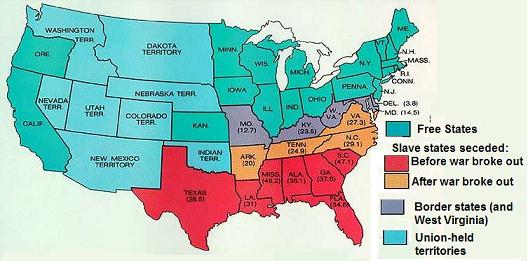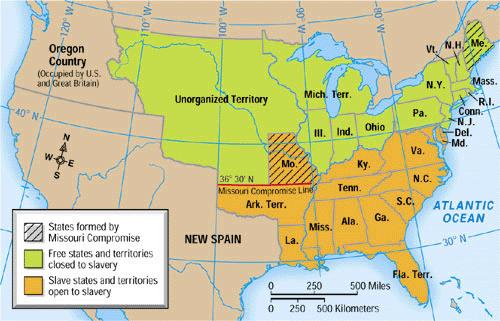STANDARD US1.9a
Issues
Dividing the Nation
a) describing the cultural, economic, and constitutional issues that divided the nation.
How did cultural, economical, and constitutional issues create bitter divisions between the North and the South?
|
Cultural, economic, and constitutional
differences between the North and the South eventually
resulted in the Civil War. |
|||
| Slavery | Cultural | Economic | Constitutional |
| • While there were several differences between the North and the South, the issues related to slavery increasingly divided the nation and led to the Civil War. | • The North was mainly an
urban society in which people held jobs. • The South was primarily an agricultural society in which people lived in small villages and on farms and plantations. • Because of their cultural differences, people of the North and South found it difficult to agree on social and political issues. |
• The North was a
manufacturing region, and its people favored tariffs
that
protected factory owners and workers from foreign competition. • Southerners opposed tariffs that would cause prices of manufactured goods to increase. Planters were also concerned that England might stop buying cotton from the South if tariffs were added. |
• A major conflict was states’ rights versus strong central government. |
STANDARD US1.9b
States' Rights and
Slavery
b) explaining how the issues of states’ rights and slavery increased sectional tensions.
How did the issues of states’ rights and slavery increase sectional tension between the North and South?
The South feared that the North would take control
of Congress, and Southerners began to proclaim states’ rights as a means of
self-protection.
The North believed that the nation was a union and could not be divided.
While the Civil War did not begin as a war to abolish slavery, issues
surrounding slavery deeply divided the nation.
| Issues that divided the nation | Compromises attempting to resolve differences | Southern Secession |
| • An important issue separating the country related to the
power of the
Federal government. Southerners believed that they had the
power to declare
any national law illegal. Northerners believed that the national
government’s power was supreme over that of the states. • Southerners felt that the abolition of slavery would destroy their region’s economy. Northerners believed that slavery should be abolished for moral reasons. |
• Missouri Compromise (1820): Missouri was a slave state;
Maine, a free state. • Compromise of l850: California was a free state. Southwest territories would decide about slavery. • Kansas-Nebraska Act: People decided the slavery issue (“popular sovereignty”). |
Lincoln and many Northerners believed that the United States was
one nation
that could not be separated or divided. Most Southerners believed that
states had freely created and joined the union and could freely leave it. Following Lincoln’s election, the southern states seceded from the Union. Confederate forces attacked Fort Sumter, in South Carolina, marking the beginning of the Civil War. |
Missouri Compromise
STANDARD US1.9c
Some States Secede, Others Remain
c) identifying on a map the states that seceded from the Union and those that remained in the Union.
 Free states, Slave
states and Border States
Free states, Slave
states and Border States| Which states seceded from the Union? | Which four slave states stayed in the Union? | Where were the other states that remained in the Union located? | |
| Southern states that were dependent upon labor-intensive cash crops seceded from the Union. | Northernmost slave states (border states) stayed in the Union. | • Free States – California – Connecticut – Illinois – Indiana – Iowa – Kansas – Maine – Massachusetts – Michigan – Minnesota – New Hampshire |
– New Jersey – New York – Ohio – Oregon – Pennsylvania – Rhode Island – Vermont – West Virginia (Western counties of Virginia that refused to secede from the Union) – Wisconsin |
| • Alabama • Arkansas • Florida • Georgia • Louisiana • Mississippi • North Carolina • South Carolina • Tennessee • Texas • Virginia |
• Border states (slave states) – Delaware – Kentucky – Maryland – Missouri |
||
